Aquariums: Leaders in Conservation Action
How aquariums are using their public presence to influence change for good and promote ocean conservation globally.
View PostBy David Levin
Published January 18, 2024
As another United Nations climate change conference (Conference of the Parties, or COP28) in Dubai, U.A,E., came to a close last month, member nations left with reason to feel cautiously optimistic. More than 200 countries agreed to begin the process of winding down the use of fossil fuels that release greenhouse gasses, marking what the UN calls the “beginning of the end” for coal, oil, and natural gas.
Throughout the two-week event, however, the impact of climate change on the global ocean—and the ways that the ocean could in turn affect climate change—remained a central part of the collective conversation. This fact was quite literally by design, said Peter de Menocal, President and Director of the Woods Hole Oceanographic Institution: along with partners at Scripps Institution of Oceanography and other leaders in ocean research, policy and philanthropy, WHOI spearheaded efforts to construct an “ocean pavilion.” This carefully designed space within the COP “Blue Zone” served as a hub for ocean experts.
Throughout the two-week event, however, the impact of climate change on the global ocean—and the ways that the ocean could in turn affect climate change—remained a central part of the collective conversation. This fact was quite literally by design, said Peter de Menocal, President and Director of the Woods Hole Oceanographic Institution: along with partners at Scripps Institution of Oceanography and other leaders in ocean research, policy and philanthropy, WHOI spearheaded efforts to construct an “ocean pavilion.” This carefully designed space within the COP “Blue Zone” served as a hub for ocean experts.
Throughout the two-week event, however, the impact of climate change on the global ocean—and the ways that the ocean could in turn affect climate change—remained a central part of the collective conversation. This fact was quite literally by design, said Peter de Menocal, President and Director of the Woods Hole Oceanographic Institution: along with partners at Scripps Institution of Oceanography and other leaders in ocean research, policy and philanthropy, WHOI spearheaded efforts to construct an “ocean pavilion.” This carefully designed space within the COP “Blue Zone” served as a hub for ocean experts.
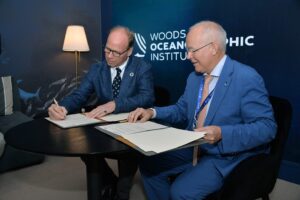

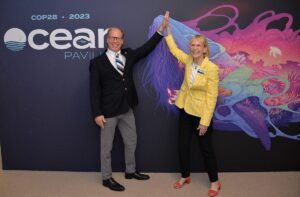
“The oceans play a vital role in governing global climate, yet the word “ocean” only appears once in the Paris Agreement.” said de Menocal. “We felt it was essential to create a gathering place at COP28 that encouraged learning and conversation around marine topics.”
With uncluttered, quiet, and comfortable spaces, the Ocean Pavilion offered an oasis away from the huge crowds at COP, and a way to rub shoulders with similarly ocean-minded attendees. Last year, a smaller version of the pavilion that appeared at the conference proved to be a popular site, pulling in thousands of visitors. This year, the pavilion almost doubled in size to cover more than 250 square meters (2691 square feet).
Inside the sprawling Dubai Expo City, this year’s pavilion created a building within a building, complete with meeting rooms, event venues, and networking spaces.
“What made the Ocean Pavilion different was our focus on people and on creating an immersive experience for everyone,” said Katherine Spencer-Joyce, Director of Creative & Web at WHOI, and lead designer for the pavilion. With input from Scripps’ Art Director Chris Toombs, architectural firm Massachusetts-based Cambridge Seven, and marketing agency 160 Over 90, the WHOI Creative team designed the 8-room pavilion.
“We had what was probably the most striking and memorable pavilion at COP,” Joyce said. “The combination of artistry, beauty, and science really made it stand out.”
On the pavilion’s walls, custom wallpaper shrouded the space in shifting hues of blue and green that evoked a sense of being immersed in seawater.
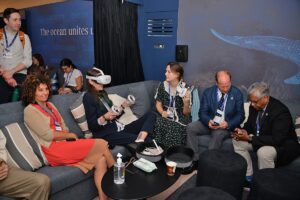
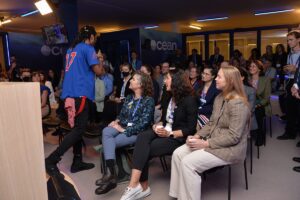
“People respond to color, so we didn’t want it to just be light blue or dark blue,” said Spencer-Joyce. “We had greens and turquoises and purples as well, gorgeous colors that make you feel like you’re within the ocean space.” Artistic restraint was also important to invite discussion, she added. Instead of information-dense panels, the pavilion’s exterior walls offered a few key facts and messages about the ocean’s vital role in Earth’s life and climate, along with custom artwork to draw the viewer in. Featured among these was Patricia Hooning’s work from a recently published children’s book about the ocean twilight zone, an under-studied layer of the ocean that plays a major role in regulating climate.
“We felt that drawings would be more inviting than photos, since they engage more of viewers’ imagination,” said Spencer-Joyce. “It was important for it to feel like this pavilion had a personality that made it engaging and original. Illustration was a great way to achieve that.”
The WHOI design team and their collaborators already have next year’s conference in mind. Spencer-Joyce traveled to Dubai to attend firsthand and returned with a litany of useful notes that she’s already putting to work in planning for COP29 in Baku, Azerbaijan. “For a designer, being able to observe how people interact with the space firsthand is critical, and it means I’ll have much richer information. It’s almost like being a scientist going down in Alvin and seeing a real-life hydrothermal vent. You don’t have the full picture until you’re there.”
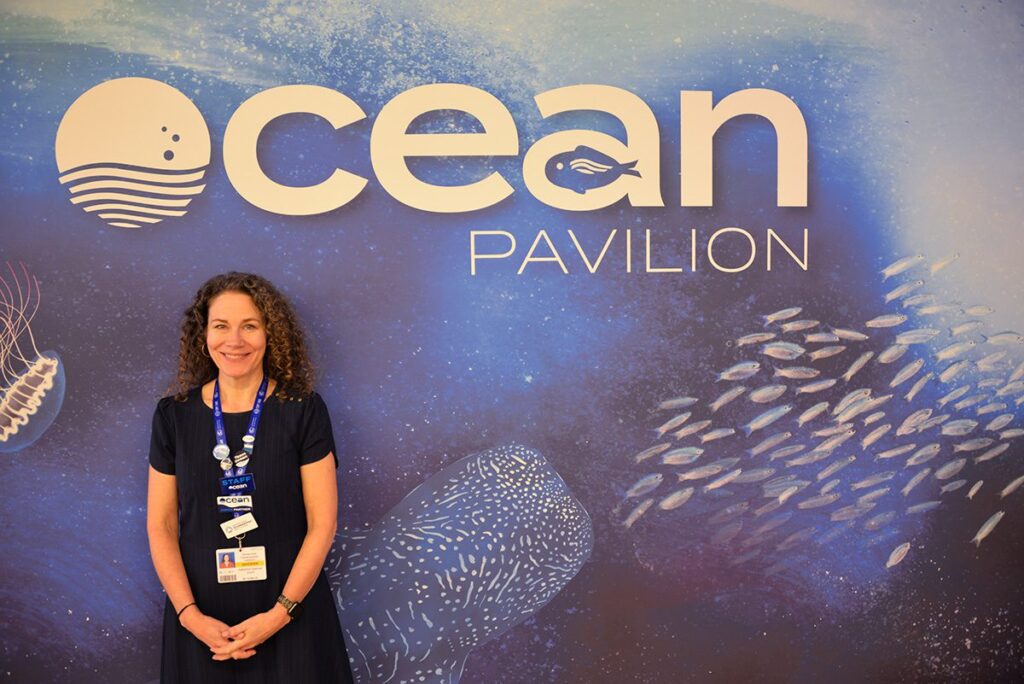
How aquariums are using their public presence to influence change for good and promote ocean conservation globally.
View PostHow aquariums are making their conservation and sustainability actions the theme of exhibits and vital components of their architecture.
View Post